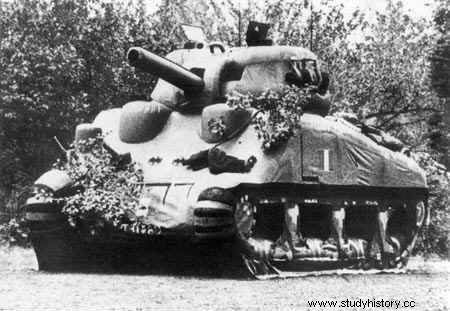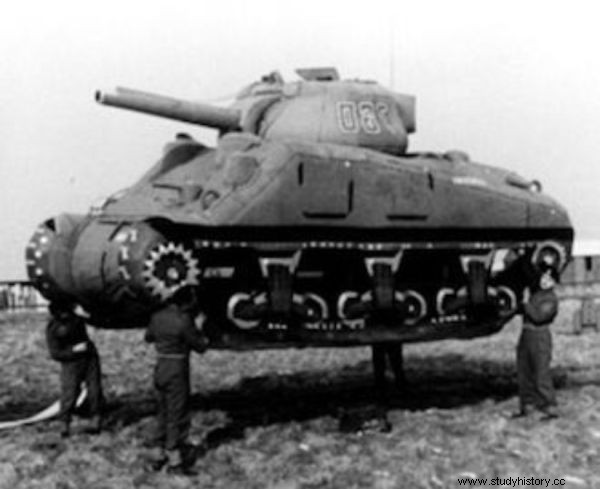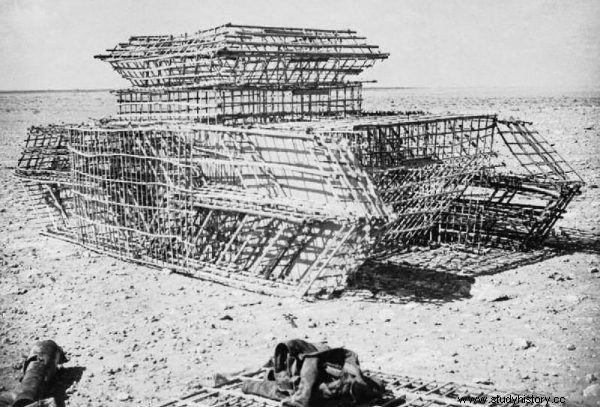As early as June 1940, when German tanks crushed the French resistance on the other side of the English Channel, the British - aware of the strength of the Wehrmacht - began to look for non-standard methods of fighting the powerful enemy. One of them was to be illusion, the art of camouflage and deception raised to a level never before seen. For this purpose, under the patronage of Churchill himself, a unique unit was created, consisting of graphic artists, painters and illusionists, and led by a film director. These people were to lead Hitler into the field, and indeed - the effect of their work exceeded all expectations.
The division was headed by Geoffrey Barkas, a director with experience on the battlefield - during World War I he fought, among others on the Somme, for which he was even decorated for. The team also included the illusionist Jasper Maskelyne. Before the war he became famous mainly for his tricks of swallowing sharp objects, incl. razor blades. However, it soon turned out that his "numbers" could outweigh the scales of victory in entire war campaigns. As late as 1940, the Experimental Cloaking Section was relocated to North Africa.
African War
In September 1940, the Italians, allied to Hitler, attacked Egypt, which was dependent on the British. Initially they were very successful, but in December 1940 the Allies launched a counteroffensive. Thousands of Italian soldiers were captured. The British and their allies (including the Independent Carpathian Rifle Brigade) seized Tobruk, Benghazi, and Bardia. The scale of the Italian pogrom was huge.

Dummy Sherman tank
The Third Reich could not allow such a turn of events. Control of North Africa and the Suez Canal opened the way to the oil fields of the Middle East. Established by a decree of Hitler, the Deutsches Afrika Korps under the command of Erwin Rommel, later known as the Desert Fox, came to the African continent in February 1941 and went into battle. The British quickly recognized the difference between Italy and Germany. Afrika Korps already closed 27,000 in April. allied forces in the Tobruk fortress.
Magic rats in Tobruk
At that time, there was already a special unit of illusionists on the African continent. Barkas and his men were active in Cairo, but one of the crew members, a filmmaker named Peter Proud, was imprisoned along with thousands of soldiers in a fortress in Tobruce. This only 28-year-old artist has already worked on the productions of Alfred Hitchcock.
Proud didn't wait with his arms folded. He ordered the construction of a huge structure that falsified the actual topography. It consisted of a vertical plane - a screen 15 meters high and 800 meters long. Pictures appeared on the screen to lead the Germans out of the field. In addition, a huge sheet was spread on the ground, with fictitious contours visible from above. Thus, a three-dimensional illusion was achieved.
The effect turned out to be so convincing that the Germans fired several thousand missiles at the model in just a few days. Planes also fired upon it. Proud also created a second model, with puppets resembling soldiers . For this purpose, he used sticks, straw and sacks. Perhaps the most important contribution of the director was, however, saving the desalination station from shelling, without which "Tobruk's rags" would not have survived the siege. Proud decided to characterize it like a ruin. The Germans bought an arranged theater and did not attack the facility.

Sometimes the Allied victory was decided by ... bluff
Mobile Alexandria
While Proud was operating in Tobruk, Barkas and his crew were working in Cairo. In June 1941, they were given the first ambitious task - to save the port of Alexandria from German bombs.
There were a few ideas, but the seemingly craziest concept won, namely moving the entire port! Jasper Maskelyne came up with it. The idea was brilliant and ambitious at the same time - to build a completely worthless dummy of the port, so that the Germans could bomb it at will. The terrain was perfect for this. The port was located only one and a half kilometers from the salty lake Buhajrat Marjut, which is separated from the Mediterranean Sea only by a narrow isthmus, but the shape of the shoreline perfectly resembles the Bay of Alexandria.
It was here that soldiers, under the supervision of specialists from the masking section, meticulously recreated port buildings from plywood, built fictitious harbors, and launched plywood and barrel ships. To add realism, care was taken to create some real artillery positions, also in order to provoke bombing with fire aimed at enemy planes.
The scam worked. Although there were occasions that the German pilots hesitated, they eventually swallowed the catch. Tons of bombs were flying in the desert sand . At the same time, in Alexandria, the effects of the bombing were simulated. For this purpose, rubble was thrown in the actual port, and sheets with painted bomb craters were spread over the city. On the second day, when reconnaissance planes were flying over Alexandria, their pilots were firmly convinced that they were watching the hecatomb after the recent bombings.
Phantom army
However, not a mobile port was the illusionist's greatest achievement. Maskelyne also developed the so-called sunshields - mock-ups that could be applied to vehicles to disguise their real purpose. Two soldiers and an hour's time were enough to turn a tank into a truck, at least for the eyes of the German pilots ...
When Erwin Rommel and his corps inflicted heavy losses on the British in July 1942, only a large railway junction at El-Alamein stood on his way to Alexandria and Cairo. At that time, the cloaking section had grown from 40 to over 140 people and was a full-fledged unit that took part in all the meetings. Barkas ordered all mock-ups and disguise devices to be brought to El-Alamein from all over Egypt. The British forces seemed greater than they really were.
The first battle of El-Alamein led to a stalemate. It was not the end of the Germans. The British were getting ready for the next fight. In order to win, camouflage was again used. As part of the so-called Operation Bertram in the south of the front, a counterfeit pipeline and military warehouses were built . On the other hand, dummy tanks were put on the trucks. All this to make the Germans believe that this is where the attack will start.

This is how the Germans were deceived by means of "illusions". The construction of the dummy tank
At the same time, a masked base ("Martello") was built on the northern section of the front, to which ammunition, supplies and real tanks were successively delivered. The latter were driving at night. They were followed by camels, pulling palm leaves and obliterating the tracks of caterpillars in the sand of the desert. After reaching the base, the tanks immediately "turned" into trucks. In turn, in the place from which they started - in the distant British hinterland - their mock-ups were placed. Thus, nothing changed in the eyes of the Germans…
D-day Theater
The Battle of El-Alamein brought a breakthrough in Africa. According to historians, the contribution of the illusionists to this victory cannot be overestimated.
Interestingly - the Germans allowed themselves to be "caught" on the same number again at the end of the war. In 1944, another phantom army was located in southern England - the 150,000th First United States Army Group (FUSAG), made of plywood, cardboard boxes and models. It was supposed to convince Hitler that the Allied invasion of the old continent would take place in the area of Calais - several hundred kilometers from the actual site of the invasion of the beaches of Normandy. The inventions of Maskelyne came in handy again, this time he developed a rubber, lightweight dummy for tanks.
Thousands of them were stationed in the fields of southern England. The theater was so advanced that not only fictional barracks, casinos and airports were built, but even the "army" was visited by King George V and General Eisenhower, headed by General Patton himself.
The masquerade had the desired effect. On June 6, 1944, at dawn, over 130,000 people landed on five beaches of Normandy. British, Canadian and American soldiers, assisted by 19,000 tanks and special forces units. The invasion was preceded by the landing of 24,000. American and British paratroopers. The coast in this place was populated only by about 10,000. Germans. The staff of the Third Reich until the end believed that the real landing would take place in Pas-de-Calais and most of the forces were concentrated there ...
